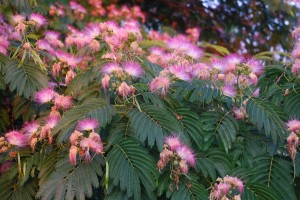Mimosa (Albizia julibrissin) is essentially a 4-5 month ornamental tree indigenous from Iran to China (USDA hardiness zones 6-9). From late spring through summer, mimosa struts an attractive fine textured foliage and beautiful flowering. This small tree rarely leafs out until mid-May (in zone 6) and offers little in autumnal leaf color. Two seedling forms, either light to dark pink feathery blooms, are common. It blooms from late June thru July and the showy fragrant flowers attract numerous hummingbirds.
Mimosa grows 20-25 feet tall of equal to broader spread. It seems at home under full sun and grows in any soil that is adequately drained. It thrives in subpar soils, often dominating a vacant or abandoned urban lot or growing along a Southeast U.S. roadside fencerow. It likely was not intentionally planted on any of these sites. Yes, seedlings may quickly become a nasty weed invader.
‘Summer Chocolate’ is a recent introduction with stunning dark purple foliage. Chocolate Fountain™ is a soon to be released weeping purple leaf cultivar from Dr. Tom Ranney at NCSU in 2015. New cultivars are attracting new gardeners who like its lacy foliage texture, color and tropics-like foliage. I urge cutting mimosa in early fall to prevent seed dispersal. Gardeners may opt to grow the foliage and forego flowering.
The notion that mimosa is an exotic invasive is debatable. Trees are not long-lived, rarely more than 20 years old. They improve the soil’s tilth and nutrition, so that one day, an opportunist native species will shine in its place.
Late winter thru early summer (February-July) is the ideal planting time. Remove unwanted and dead branches at any time. Fertilizing mimosa trees is unnecessary as roots fix their own nitrogen.


 Posted in
Posted in 
